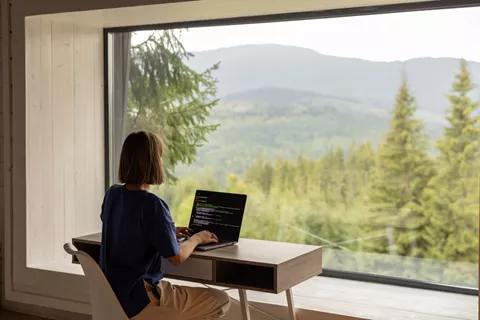How Much Office Space Do I Need Per Employee?
By Varun Bodhi

When setting up a new business or moving to a new location, one of the most important questions you’ll need ask is how much office space do I need?
The short answer is: it depends.
Different types of businesses will have different office space needs, and you will have to take into account the future needs of your business. If your business is growing, you will need to plan for this with your office space.
There are many factors you’ll need to consider to get the perfect sized space for your needs. Below, we look at average office space for different types of businesses, how to plan your office space and a guide to calculating office space to help you work out how much you’ll really need.
Why Office Space per Employee Matters
Your office space is more than just a place to work – it's a reflection of your company's culture and values. The right amount of space per employee sends a message about how much you prioritise their well-being and potential.
A carefully planned office space will ensure your business fosters a work environment with collaboration, innovation, and productivity. There are also many benefits!
- Reduced costs: An optimised office space will reduce overhead costs, such as rent and utilities.
- Employee satisfaction: Employees with enough office space can work comfortably and are more likely to be happy and engaged with their work.
- Improved productivity: An office that considers design can help reduce distractions and improve focus.
But the perfect amount of office space is a tricky balance – too little, and your team suffers; too much, and you’re wasting finances. How do you find the perfect amount? Keep reading to discover the ideal workspace formula for your business.
How much office space do I need per employee?
The Building Code of Australia requires a minimum space of 10 square metres per person in the space. But many businesses will need significantly more than the minimum.
It’s important to note that the minimum space requirement takes into account the entire space, including ancillary office space such as meeting and common rooms, hallways and bathrooms. So with the minimum space, employees would have much less than 10 sqm for their dedicated work area.
High density offices such as call centres may be able to operate at this minimum, but the average office will need to be bigger, especially for professional services such as accounting or law, where more private office space is needed.
Having bigger, open office space architecture and more common rooms can also help with employee satisfaction, resulting in improved productivity.
Those who work in creative fields can also benefit from open and airy types of environments and the ability to move across different spaces within the office.
How many staff are full-time and how many are part-time or casual may also influence how much office space you need. Likewise if employees sometimes work from home. Using shared desks for staff who aren’t in the office everyday can help you cut down on office space needed.
What is the the typical size of an office space?
The total size of an office space will depend on the total number of employees.
But the average space per employee for a general office is around 12-14 sqm per person.
Professional services businesses like accounting or law firms often need more private office space and generally require around 14-20 sqm per person.
Though many contemporary office spaces for these types of businesses are becoming smaller, as businesses become more efficient with how they use space.
Many businesses are also moving towards “creative office spaces” which go beyond the traditional office layout to provide a unique and highly desirable space for their employees. This can help with attracting and retaining top talent, and with improving productivity and morale. These types of offices have similar requirements to professional services businesses, around 14-20 sqm per person.
A relatively new movement in office space is agile office space design, which provides layouts to suit a variety of different types of work and employees. Agile offices have open central spaces as well as smaller, private rooms for more individualized work. These types of spaces are very flexible and can work with almost any type of business.
Remember, there is no “one-size-fits-all” answer when it comes to how much office space you need – every business is different.
Factors Affecting Office Space Requirements
While we have provided a generalised number for the recommended amount of office space per employee, there are several factors that will change this number.
- Employee roles:
- Workers who spend the majority of their time at their desks (such as programmers or designers) need more workspace.
- Employees who commonly meet with clients or collaborate with others can benefit from shared spaces or larger conference rooms.
- A worker who is commonly on the road or out of the office will require less dedicated space.
- Equipment needs
- Consider the size and amount of equipment used by each department in your business. Large machinery or technology will need more office space.
- Allocate room for storage when equipment is not in use or is about to be thrown out.
- Privacy requirements
- Office roles that involve confidential information sharing (e.g., HR & finance) might need private offices or soundproofed areas for privacy.
- Some tasks might require dedicated quiet areas.
- Future growth:
- Your business is malleable and it should leave room for flexibility to accommodate new hires without squeezing in too many people in cramped space.
How to plan your office space
You shouldn’t settle for the first office space you see without considering a range of variables. Your workspace needs careful strategic planning, and here are some critical factors Servcorp recommends considering:
Understand your organisational strategy
Your office space should reflect your brand and the impression you want to make on your customers and employees. It should also take into account the needs of your employees, how they work together and the type of work they do.
- Brand and Culture: Does your work environment align with your company’s image? Select a space that envisions your business values and one that will create a great experience for clients and employees.
- Workflow and Collaboration: It’s crucial to analyse your team’s day-to-day work patterns when selecting an office. Do they prefer an open and dynamic environment, or require a mix of private and shared zones?
Business objectives
Your office space should support your business objectives, which could include reducing costs, fostering greater collaboration between teams or improving productivity. You may also be looking to create a desirable office space to attract and retain top talent.
- Cost Efficiency: Can your office space help optimise expenses? Think about rent, utilities, and how the layout impacts resource usage.
- Productivity: Consider how the layout can minimise distractions, streamline workflows, and improve efficiency.
- Talent Attraction and Retention: A modern, well-designed office space can be a powerful draw for top candidates and boost employee morale.
Future needs
When you rent office space, you will most likely be signing a long-term lease. So think carefully about where your business is heading in the next few years and discuss any flexible options available. Is your team growing or shrinking? Will more employees be working remotely in the future?
- Growth Projections: Is your company expanding? Downsizing? Factor in potential fluctuations in workforce size over the lease term. Perhaps a flexible workspace such as coworking or a serviced office is more appropriate if your business is more malleable.
- Remote Work Trends: A hybrid or remote business will need to consider how to efficiently roster their employees and how this will impact the office space per person.
- Flexibility: Explore options like modular furniture, adaptable spaces, and the potential for subleasing if your needs change drastically.
Type of layout required
This will often depend on type of your business and what sort of work you do. Do you need private offices and spaces? How many meeting rooms and common areas do you need?
- Private vs. Open: Workstyles are evolving, and employee satisfaction is heavily dependent on the office space. Determine an ideal split between private or shared areas in the office.
- Meeting Room Variety: Do you need large conference rooms, small huddle spaces, or phone booths for private calls?
- Informal Collaboration Zones: Breakout spaces, cafe areas, or even comfortable seating arrangements encourage spontaneous interaction and idea generation.
Additional Considerations
- Technology infrastructure: Ensure wiring, outlets, and network capabilities support your current and potential future tech needs.
- Natural Light and Ergonomics: Prioritise employee well-being with access to daylight and comfortable, adjustable workstations.
- Accessibility: Design with inclusivity in mind, ensuring your office space accommodates the needs of all employees.
What types of spaces are required for different employees?
Some employees may benefit from open spaces allowing easy collaboration and communication between team members, while others may need more private spaces for meetings and phone calls. Those working in creative fields might benefit from multiple spaces to work in, rather than being stuck at a single cubicle or desk. While those within the legal or financial industry may need the privacy of an office for confidential call and meetings.
Ultimately, there's no single answer, as needs vary by role. Here's a guide to common space types:
- Dedicated Workstations: Ideal for focus-intensive tasks, handling sensitive data (e.g., programmers, finance).
- Open Collaborative Zones: Facilitate teamwork and idea-sharing (e.g., creative departments, project management).
- Private Offices: For confidential work, frequent calls (e.g., HR, executives).
- Focus Pods/Rooms: Offer temporary quiet zones for anyone needing distraction-free work.
- Meeting Rooms (Varied Sizes): Accommodate small huddles to big presentations and consider booking systems.
- Informal Breakout Spaces: Boost morale and connections (think comfy lounges and kitchenettes).
- Wellness Rooms: Support employee well-being and privacy needs.
Key Point: A mix of these spaces is often optimal. Get employee feedback to tailor your office perfectly.
Cost
Cost is a large factor and the bigger your office space the higher the cost will be. But a cramped, uncomfortable environment may cost you more in the long run through lower employee productivity, morale and run the potential risk of losing top performers. It’s important to provide your team with a space in which they can thrive and a good office space can help attract and retain talent. Try to find a happy medium between value and office size. The amenities such as end-of-trip and perks within the building should also be taken into cost consideration.
How do I calculate how much space I need?
When calculating office space, every business's needs are different, so you’ll need to decide for yourself what your optimum space will be.
However, the table below can be used as a helpful guide to give you an idea of the range of office spaces sizes that will suit different sizes and types of businesses.
|
Number of employees |
High density office space |
General office space |
Private offices or creative spaces |
|
1-10 |
Up to 100 sqm |
Up to 140 sqm |
Up to 200 sqm |
|
11-50 |
110-500 sqm |
132-700 sqm |
154-1,000 sqm |
|
50+ |
500+ sqm |
600+ sqm |
700+ sqm |
*Note, high density spaces are based on 10 sqm per person, general office on 12-14 sqm per person and professional or creative services bases on 14-20 sqm per person. These also include common areas.
This table is a great starting point for understanding minimum metrics, but determining your ideal office space goes beyond a formula. Here are some steps to create a more accurate calculation.
- Analyse Current Usage: If you have an existing office, observe how it's being used.
- Are desks frequently empty? Are most of your employees working remotely? This could indicate room for downsizing.
- Are meeting rooms overbooked or common areas overcrowded? Are employees feeling cramped? This suggests a need for expansion.
-
Use an Online Calculator: Many free tools exist online, and they can assist in tailoring your workspace. You will be asked detailed questions about your business and output a more personalised square footage recommendation.
Beyond Square Footage
- Efficiency: A well-designed 800 square meter office can feel more spacious and functional than a poorly laid-out 1000 square meters.
- Noise Levels: Open-plan offices require attention to acoustics to mitigate distractions.
- Natural Light: This impacts productivity and well-being; a larger space with poor lighting will strain employees' eyes and cause fatigue.
Finding the right office space for you
To find your perfect physical office space, make sure you consider all your needs and the key factors that influence office space size.
Having all of this information clear in your mind will improve your office space planning and help you make the best decision for your business.
Contact us today to find out more about Servcorp's Serviced Office solutions.
Contact Us
If you’ve got any questions call us 1300 409 755 or fill in your information below and we’ll get back to you shortly.





